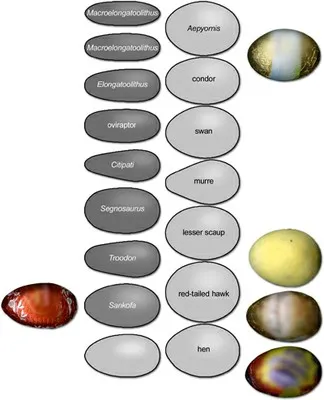Dinosaur Egg Hunt
A well-timed analysis suggests that non-avian dinosaurs, not the Easter bunny, are the best candidates for laying the candy eggs hidden away on lawns
/https://tf-cmsv2-smithsonianmag-media.s3.amazonaws.com/filer/dinosaur-tracking-easter-eggs-470.jpg)
Every kid knows how Easter eggs wind up in their yard. According to the canonical weirdness that is the holiday tradition, the Easter bunny delivers the colorful eggs overnight. But the origin of the eggs themselves is hardly ever mentioned. According to a well-timed press release from the University of Leicester, non-avian dinosaurs are the best candidates for some of the candy eggs hidden away on lawns.
There is some real science behind the silliness. In the latest issue of Palaeontology, researchers Nieves López-Martínez and Enric Vicens described a new type of dinosaur egg discovered in the Cretaceous strata of northeastern Spain. The roughly 70-million-year-old eggs, given the name Sankofa pyrenaica to distinguish them from other egg forms previously found, exhibited a strange combination of features.

Many non-avian dinosaur eggs are more or less symmetrical in shape, regardless of whether they are spherical or elongated. Bird eggs, such as those from hens, often have an asymmetrical, tear-drop shape in which one end of the egg is more pointed and the other more rounded. There is some overlap in form, though. Eggs attributed to the small, sickle-clawed dinosaur Troodon and to the beaked oviraptorosaur Citipati are both elongated and taper to one end, and so seem similar to bird eggs.
The profile of the newly described egg type is most similar to that of archaic birds. But, according to López-Martínez and Vicens, the microscopic structure of the Sankofa eggs shares more in common with those laid by non-avian dinosaurs such as Troodon than with birds. The Sankofa eggs exhibit a mix of characteristics seen in both non-avian dinosaurs and archaic birds. Without fossils of the chicks developing inside the eggs, or even associated bones of adult animals, exactly what sort of creature laid this egg is ambiguous.
As part of the study, López-Martínez and Vicens created a chart of non-avian and avian dinosaur egg shapes. And, while it didn’t resolve the true identity of Sankofa, University of Leicester paleontologist Mark Purnell employed the comparative diagram in an attempt to track what sorts of dinosaur—avian or otherwise—could have laid the colorful eggs offered in England’s shopping districts. While many treats had the traditional hen egg shape, Purnell found, at least one resembled the Sankofa egg shape. I have to wonder if other Easter egg variations fit within the non-avian dinosaur range. Perhaps an expedition to the supermarket is in order.
References:
LÓPEZ-MARTÍNEZ, N., & VICENS, E. (2012). A new peculiar dinosaur egg, Sankofa pyrenaica oogen. nov. oosp. nov. from the Upper Cretaceous coastal deposits of the Aren Formation, south-central Pyrenees, Lleida, Catalonia, Spain Palaeontology, 55 (2), 325-339 DOI: 10.1111/j.1475-4983.2011.01114.x
/https://tf-cmsv2-smithsonianmag-media.s3.amazonaws.com/accounts/headshot/RileyBlack.png)
/https://tf-cmsv2-smithsonianmag-media.s3.amazonaws.com/accounts/headshot/RileyBlack.png)